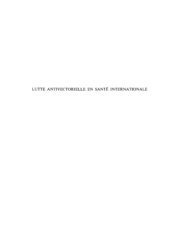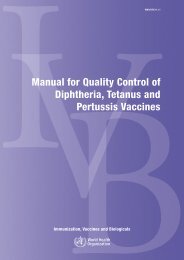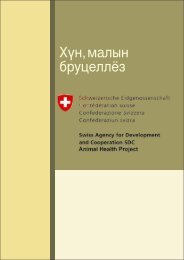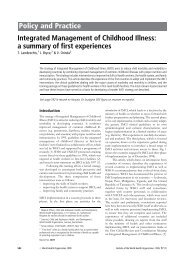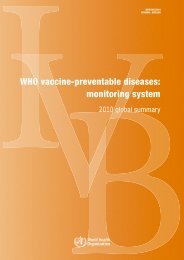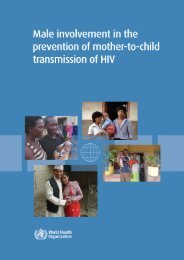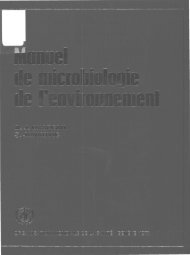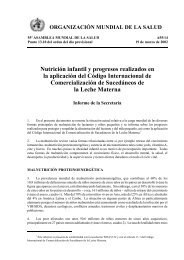Regulatory Situation of Herbal Medicines A worldwide Review
Regulatory Situation of Herbal Medicines A worldwide Review
Regulatory Situation of Herbal Medicines A worldwide Review
Create successful ePaper yourself
Turn your PDF publications into a flip-book with our unique Google optimized e-Paper software.
WHO/TRM/98.1page 13DenmarkUnder the Danish Ministry <strong>of</strong> Health Order No. 790 <strong>of</strong> 21 September 1992 [47], natural remedies covered by theauthorization system are defined as follows:- Natural remedies shall be understood to mean medicinal products in which the active substance(content) exclusively comprises naturally occurring substances in concentrations that are notsubstantially greater than those in which they are found in nature.- The order applies to natural remedies intended for oral use or application on skin or mucousmembranes. It does not apply to remedies containing prescription-only drugs, nor to homoeopathicmedicines.Combinations <strong>of</strong> natural remedies with added vitamins and/or minerals cannot be marketed as naturalremedies. Pro<strong>of</strong> <strong>of</strong> quality, safety and efficacy must be given; a bibliographic application with respect totherapeutic use is accepted if it contains descriptions in the relevant scientific literature <strong>of</strong> Europe or NorthAmerica [47,48].EstoniaOn April 1 1996, the "Medicinal Products Act" became effective, laying down the general requirements <strong>of</strong> theprocedure for registration <strong>of</strong> medicinal products and approval <strong>of</strong> variations to the terms <strong>of</strong> registered medicinalproducts [49]. For the application, a special form has to be used and additional documents concerningchemical, pharmaceutical, biological, pharmacological-toxicological and clinical information has to besubmitted, with a summary <strong>of</strong> product characteristics and information concerning price and design <strong>of</strong> thepackage [49]. Special rules governing application for herbal medicines are in preparation.FinlandAdministrative regulation 9/93 [50] regulates the status <strong>of</strong> herbal products in Finland. It takes into account theprovisions <strong>of</strong> Directives 65/65/EEC [30] - especially article 4.8 (a) (ii), 75/318/EEC [31], and 75/319/EEC [33]with later amendments. <strong>Herbal</strong> products contain traditionally used plants or their parts as such or in driedform, extracts or tinctures prepared from them, or traditionally used essential or fatty oils.In accordance with the European Directive 75/319/EEC [33], an expert report shall be submitted on thepharmaceutical and chemical characteristics. With regard to these, a summary based on the applicationmaterial shall be submitted which briefly describes the main indications for the products, the usual dose,mechanism <strong>of</strong> action, side effects, interactions with other medicinal products, and other facts which themanufacturer considers to be <strong>of</strong> significance in the evaluation <strong>of</strong> the application [50].The documentation on pharmaceutical and chemical characteristics shall be presented in accordance with theEuropean Directives 75/318/EEC [31] and 91/507/EEC [32] which are applicable for all kinds <strong>of</strong> medicinalproducts. The particulars on the quality and manufacture <strong>of</strong> herbal remedies shall further take into account theEuropean guideline "Quality <strong>of</strong> <strong>Herbal</strong> Remedies". Raw materials have to meet the requirements <strong>of</strong> thepharmacopoeia or, if there are none, detailed quality requirements shall be drafted in accordance with themodel <strong>of</strong> the monographs <strong>of</strong> the European Pharmacopoeia. Quality requirements for intermediate andfinished products have to be presented, the latter covering, for example, identification and determination <strong>of</strong>active ingredients with validated methods, and a purity test. If the product contains more than one herbalremedy, these shall all be identified e.g., by the TLC finger print method.The applicant shall present a proposal for the indications <strong>of</strong> the product, its dosage and, where necessary, itsinstructions for use. If the herbal remedy or its active ingredient has been used for a long time in Europe or incountries close to Europe with regard to their health care traditions, the safety and proposed indication <strong>of</strong> theproduct can normally be explained by information available in scientific literature, which shall be verified inaccordance with the European Directive 91/507/EEC [32]. If this cannot be reliably verified, an application for amarketing authorization with a full dossier shall be made. Where a bibliographic application is made, copies <strong>of</strong>the references in the scientific literature verifying the safety and indications <strong>of</strong> the product shall be submitted.The application shall also include a bibliography <strong>of</strong> the material that is appended or otherwise referred to inthe application. Proposals for labelling and the package leaflet and the Summary <strong>of</strong> Product Characteristicsshall be submitted to the National Agency for <strong>Medicines</strong> together with the application. The label <strong>of</strong> a herbalremedy clearly states that it is a herbal remedy [50].<strong>Herbal</strong> products are normally sold in pharmacies with the exception that, if they are not registered as



